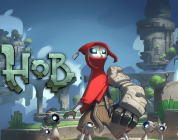She’s the original Fly Girl of In Living Color — Game Boy Color, that is. Shantae, our favorite purple-haired, gold-bangled half-genie hero first made her debut in 2002. Despite the fact that the Game Boy Advanced was released in 2001, Shantae’s debut adventured conjured a cult following. Whipping forward eight years, Shantae cast a spell on DSi with Risky’s Revenge, which was originally a DSiWare exclusive. After surviving a labyrinthine nightmare, and deserts that burn hotter than her spell-wielding dance moves, Shantae returns yet again with a new adventure in Shantae and The Pirate’s Curse, and this time she will be flicking her follicles at foes alongside one of her worst enemies.
As the game begins, we find that Shantae is both relieved and elated to be back in her beloved home of Scuttle Town, which she’s sworn to protect. Sadly, due to the events of the game she previously starred in her genie powers are MIA. Not given much time to address the emotional turmoil any half-genie would be bound to feel over these disparate emotions, she’s suddenly confronted with her arch nemesis Risky Boots (du-du-dahhhhhh)! Wanting to lock away the past like a giant ruby in a pirate’s chest, she informs Shantae of a nefarious plot orchestrated by the mysterious Pirate Master. Our new frenemies dust off their sabers, steam their billowing harem pants and set off on an adventure of a lifetime.
The Shantae series is a winning mixture of exploration, close range combat, platforming, and is quite possibly one of the finest examples of a Metroidvania game to-date. With controls tighter than a pirate wench’s corset, WayForward combines the standard right hand action buttons/ left hand directional control with well-implemented 2nd screen touch controls; world map, quick-use items and inventory are all easily accessible with just a tap. These tight controls will come in handy as you’ll need all the help you can get. Don’t let the colorful, 16-bit era inspired sprites and the cool diorama look the 3D effect gives the game blind you to the rapid change in the difficulty level as you progress through of the game. The game is twice as long as its predecessor, Risky’s Revenge, and the locales varied themes like a tropical island overrun by malicious mermaids to a spooky forest with flesh-eating creatures that definitely go bump in the night.
Speaking of enemies, the red-skinned monsters and flying eyeballs you’ll encounter become stronger, as do the environmental puzzles you’ll need to solve in order to progress. As the game gets harder, Shantae grows in strength as well. You’ll learn new moves and collect discarded pirate weaponry that will help balance the scales of injustice. Through trial and error, you’ll learn your enemies’ weaknesses and slowly unravel the logic behind the obstacles that stand in Shantae’s path.
Normally if a game shows me that there will be a lot of backtracking that isn’t necessary to complete the game, I am rather quick to make a beeline for the finish of the game. However, in Shantae and the Pirate’s Curse the backtracking and seemingly endless exploration is made much more enjoyable by the game’s phenomenal soundtrack. Jake Kaufman, a rather prolific video game music composer, has put together a wide range of retro sounding tunes that fit the game’s visual aesthetic. Scouring each of the game’s maps for hidden passages won’t just net you items to power up our favorite swashbuckling pirate, but it will also be an excuse to spend 1001 nights listens to all of the Arabian tinged chiptunes this game has to offer. From sea shanties to cinematic adventure tunes, this game truly has it all and has the distinction of being one of the few video game soundtracks I would enjoy listening to all on its own.
These days, it’s pretty easy for me to tell a platformer to sashay away. The genre is feeling a bit tired overall, but WayForward managed to make their game feel fresh, while still pouring on enough nostalgic charm to make my ancient, decrepit gamer heart swell with happiness. This game is the pinnacle of Metrodvania goodness, with evolving monsters, heroic weaponry, diverse environmental design and some truly noodle-scratching puzzles that will make even the sharpest of minds feel like they’re about to walk the plank into a sea of confusion. When you hear the game’s music, you will feel as though you have been instantly transported to a harem filled with all of the most fabulous SNES games imaginable. As you shimmy through its many hidden tunnels, the game will weave a bewitching spell over you and it will leave one phrase on your mind: “Shantae, you can stay.”












